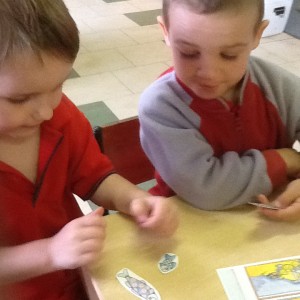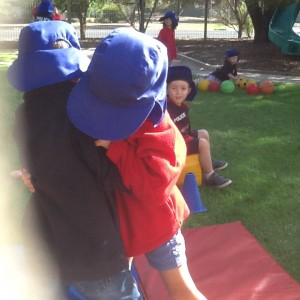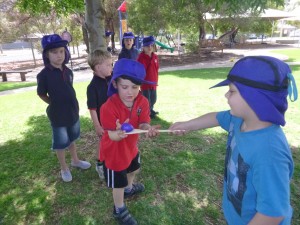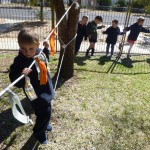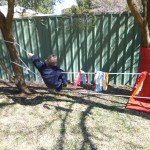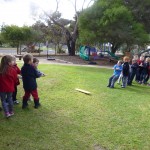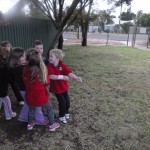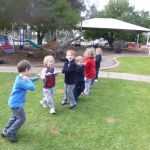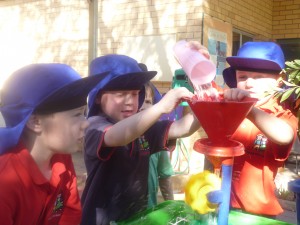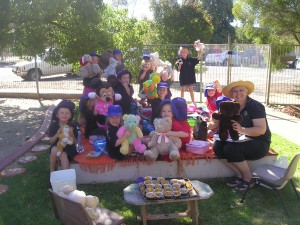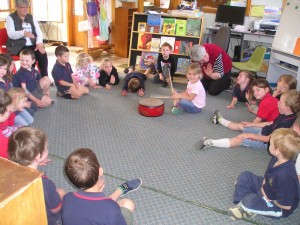This week the children have been enthusiastic about playing a new game – modelled on hunting practices by the Aboriginal people on the Loddon Plains in Central Victoria – where the hunters had to creep and run after a kangaroo, but be ready to freeze if the kangaroo turns to look around for danger. There are some real strategists in the group – and they have been able to creep up on unsuspecting kangaroos and catch them before they turn around next. On a cold autumn day, every child has been running, ducking and freezing – and trying not to make a sound (a hard thing to do but excellent practice for executive skill development!)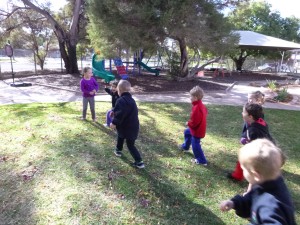
Category Archives: Games & Activities
Listening and following instructions
Oral language skills are fundamental to communication and social development and of course to all academic learning. There are lots of opportunities to weave practice for these into daily life, but in a group situation, some children can still slip through and there is value in doing a focussed activity with a small number – and the children spark each other’s learning then.
On Monday we had children telling stories about their fish cards – and it showed again how important STORY is to language and learning.
Rough and tumble
We have some children who really seek vigorous physical activity and deep muscle work. Sometimes they choose to relate very physically to each other, so I offered them some wrestling – along with some rules. Only two combatants. If you get pushed off the mats onto the grass or brought down onto the ground, the match is over. Each couple must shake hands and show respect to each other before they start.
We had lots of children lining up to have a turn, not completely along gender lines, one girl was very keen, and two others were happy to do it with each other, not with a boy, as the boys were definitely more experienced in this sort of rough and tumble play. Placing this activity into a more formal context, with rules and a spirit of respect, removed the potential for aggression and hurt feelings that sometimes accompanies rough contact.
and eggs again!
Egg and spoon races are a fun way to connect with the children’s enjoyment of all things eggy. The “races” are strictly for participation, not prizes.
The challenge to focus and balance and the resilience needed to pick it up and start again are both great lessons in this game. And the satisfaction in conquoring a new skill is clear.
a ropes course
We are always looking for ways to challenge and engage all children in different ways – our very active children love climbing and stretching themselves. Our educator, Bev, suggested a ropes course. We are a bit limited by the location of the trees but we have put one up.
We discussed safety and everyone attached a strip of fabric to make sure people could see the ropes when they are playing nearby.
There were lots of ways to get across the course and some children kept on practising. Resilience in action.
Tug o’ War
It started with 2 boys. They were each pulling at a piece of curtain material – just to gain possession, it seemed. The only one that was going to give way was the fairly flimsy fabric in the middle. We rescued the curtain and found a skipping rope instead. Suddenly lots of children were there. Sorted out into hopefully equal teams and learning the “rules” was quick – then we were playing tug o’ war. Surprisingly the teams really were equal, both in strength and determination. The rope stretched but didn’t break and the teams came out equal!
the way play looks today
Play is so many different ways of being and interacting with the world. How do we create opportunities for a range of play – how interesting is it? How much choice and self direction is there?
Magnifying glass bingo – for the children who are keen to use this new science tool. It quickly became self directed and enjoyable
Block play for the budding town planners and architects …..
Engineers building a water machine…
Setting up their own office spaces with their chosen props; catching up on the phone….
focussing on sensory and manipulative play with marble scooping in water ….
or hopping on the kinder bus, sharing and contributing ideas, letting the baby drive it.
The kinder Olympics!
All the children have seen something about the Olympics on the television – and the gymnastics has especially captured their interest. So we did some of our best moves for each other……
…first as a group – showing off our balancing and stretching skills…
and then in the individual event…(Mia knows that gymnasts do a really fast run up before they do their somersaults and other tricks…)
….. Arley knows that they have to freeeze when they land…
…. and so does Kristy….
and when in doubt, we can always add a roll in there, like Regan.
In these Olympics, it’s having fun that wins the day, but I had to include a shot of our rowing team – hard work can also be fun.
The joy of bears (and honey)
We had a visit from our teddy bears to finish the term off.
They helped us to eat the honey joys we had made on Tuesday.
Which tasted great outside at our picnic.
And we played “8 in the bed” – twice – and so everyone was able to get a go.
Every bear (or other friend) was different – but they all had fun at kinder!
drumming
Drums are very popular with this – and every – group, maybe because beating the drum can be a satisfyingly large motor activity? They are popular with us as educators because there is so much to learn – from gross to fine motor, patterning, rhythm, like all music they are great for auditory learning, they support lots of songs, they promote knowledge of diverse cultures and music, and they are fun!
Anyway we have had just the drums out this week – with the addition of two new drums. These new drums are real ones, with the excitement of the real – made of natural materials like wood, skin and fired clay, that can be broken if not handled with care – and which impart to the user a sense of importance and responsibility that 4s and 5s relish when given respect and an opportunity to practise careful handling….
We already had our set of drum tops, a clever way to make the drums more portable and to be able to afford a set of different ones. They are popular for our marching bands….
We have started to learn Joy Lubawy’s indispensable drumming song – “This is how the big tall Indian plays upon his drum”, taking it in turns to play the drum in the group while the rest of us beat our drums on the floor….
In a smaller group, such as the pre-kinders, the children can play a game with their music – playing up high and down low, and then in the middle, quiet or loud, slow or fast, or any which way….
Drums are fun!
